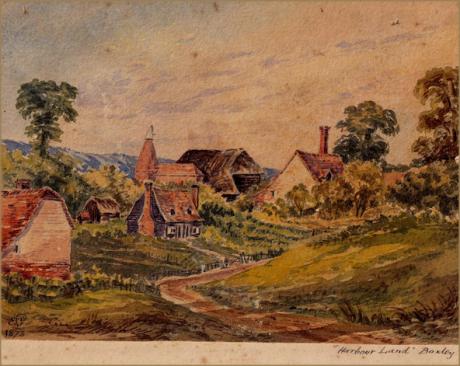signed with monogram and dated " E.T.L. 1873" and furthe rinscribed in the margin " Harbour Land Boxley"
Harbour Land Farm House is Late 16th Century it was partly rebuilt in C18, with C19 additions. Timber framed; ground floor is brick, first floor tile hung with thick bands of plain and fischscale tiles. Plain tile roof. There is a Late C16 2-bay cross-wing with large C18 bay to right, very narrow C18 addition to left, another large C18 bay to rear of right bay, and large C19 addition filling in the left rear corner. 2 storeys and cellar with brick plinth above a small stone plinth. Roof hipped at right end. Projecting truncated brick stack at left end and ridge stack in rear right wing. Irregular fenestration of 3 two-light casements, 2 towards left end, one to right of centre. Single storey brick lean-to with plain tile roof at left gable end, abutting the stack, with C20 halfdoor. Interior: has exposed beams and posts.
Barn, with added oasts, part subsequently converted to cottage and stables, all but stables now a house. 4 bays of barn late C16, fifth bay added to north in mid C18, oasts mid-tolate C18, 2 north bays of barn converted to cottage very late C18, stables created late C19.
Timber framed, 2 north bays tile hung with thick bands of plain and fishscale tiles, rest weather boarded, with plain tile roof. 5 timber-framed bays parallel to road and 2 oasts added, parallel to each other, at right angles to rear of 2 south end bays. Front elevation (west):- 2 storeys, roof hipped at right end with gablet. Rear stack at left end. Tile-hung area has one recessed 2- light casement at right end of first floor. Double barn doors off-centre to right with 2 C20 square glazed lights, and single door with square glazed light adjacent to left. Smaller double doors in first floor above ground-floor double doors. Oast to rear at right end has stables in ground floor with hatches and casements above. Both oasts have hipped roofs. Interior: roofs, beams and posts exposed. In right oast, evidence of internal kiln and rare survival of part of stud and plaster partition between plenum chamber and unheated part of oast. Left oast has unique arrangement of girder and joists set diagonally. Original
barn roof has clasped purlins with reducing principal rafters, cambered collars, and rare evidence for unbraced crown strut to centre of collar. No wind braces.
Boxley lies below the slope of the North Downs approximately 2 miles (3.2 km) northeast of the centre of Maidstone town. The civil parish has a population of 7,144 (2001 census), increasing to 9,554 at the 2011 Census, and extends to the north and east of the town including the settlements of Boxley itself, Grove Green, most of Weavering Street, Sandling and the southern extremities of Walderslade and Lordswood at the top of Blue Bell Hill.
The M2 and M20 motorways cross the parish to the north and south of the village and the High Speed 1 railway line passes to the south of the village in cuttings and tunnel. Despite being so close to Maidstone and two motorways, the village is surrounded by woodland, and still retains a village feel. The ruins of Boxley Abbey are located here. The parish church is dedicated to St Mary and All Saints.
The church and the Abbey Barn are both Grade I listed buildings and the site of the abbey is a scheduled monument. Boxley Abbey House, Parsonage Farm and St Andrew's Chapel in Boxley and Weavering Manor in Weavering Street are all Grade II* listed. The Pilgrims' Way trackway and the North Downs Way pass through the parish. The village was the filming location for the film version of Porridge.
Within the parish are the Museum of Kent Life and Vinters Valley Nature Reserve. A 19th-century granary from Boxley was dismantled and re-erected at the museum.
"Vinters" was a country house and home to the Whatman family until is was demolished in the 1950s. Susanna Whatman was the first of her family to manage the house and the guide she wrote was published in 1952 - about 200 years after her birth.


